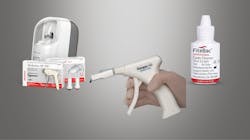I have it—you want it! Compex HD, Biodentine XP, FiteBac
Compex HD
There are several composite warming devices on the market, and the research on using a warm composite has been well documented. However, it always bothered me that while there was a device to warm the composite—be it in a syringe or unit dose—there was a period of cooling from the point of loading the material into a dispensing unit and/or placing it into the cavity preparation. That is no longer the case with AdDent’s latest composite warming unit, the Compex HD.
More I have it—You want it!:
This unique, handheld, rechargeable device will accommodate most unit dose compules and heat them in one to two minutes to 155⁰. Furthermore, it will retain its charge for about 100 uses and has a full recharge time of about four and a half hours. The beauty of the Compex HD, and the reason it is the right answer for warming composite, is that it warms the composite as you deliver it to the restorative site. Advantages to composite warming include greater depth of polymerization, better adaptation to cavity walls, less microleakage, shrinkage, and shrinkage stress, which can translate to a longer lasting restoration. The Compex HD “gun” is ergonomically designed and lightweight. Of course, there are barrier sleeves for the handle and unique silicone sleeves that seal the composite orifice for maximum infection control. Compules are easy to load, safely retained, and then simply ejected with a patented ejector mechanism. If you have been on the fence about composite warming, this is a great device to try.
Biodentine XP
I applaud any manufacturer who has a great product and invests the time in the research and development phase to make it even greater and easier to use. Such is the case with Septodont’s Biodentine XP, a wonderful therapeutic tricalcium silicate material proven to reduce the risk of bacterial intervention and sensitivity.
The new Biodentine XP provides a consistent, perfect mix every time due to its innovative new mixer that is preset, has a small footprint on your counter, and is quieter than most triturators. Dispensing is easy with their proprietary, ergonomically designed, autoclavable applicator gun. “From mix to the mouth” makes for greater speed and accuracy of placement into the area being restored. There are two capsule sizes—XP200 and XP500—which provide ample material dependent on the need. As with Biodentine, Biodentine XP can be used in both indirect and direct pulp-capping procedures and as a base for deep restorations to correct or prevent pulpitis due to its biocompatibility and anti-inflammatory effect. Endodontic uses include pulpotomies, repair of perforations, internal/external resorption, apexification, and retrograde surgical filling. The material is radiopaque and has a reasonable cost per use ratio. Ten years ago, I thought this took dentin repair to a whole new level. Kudos to Septodont for raising its own bar.
FiteBac
An important but often overlooked step in restoring a tooth is the use of a cavity cleanser prior to placing an adhesive bonding resin and subsequent restorative material. This important step in cleansing and rewetting the exposed dentin is easily performed with FiteBac.
This economical liquid material can be applied with a microbrush applicator or small cotton pellet. Once applied, it will remove debris but will also penetrate into dentin tubules, thereby allowing the adhesive restoratives to tightly bind to the dentin surface. Independent studies have shown that FiteBac acts on microorganisms such as Streptococcus mutans, Actinomyces naeslundii, Lactobacillus acidophilus, and Candida albicans. FiteBac 2% contains K21 QAS, which has four quaternary ammonium structures linked to a silicone core. This allows for the material to provide excellent antimicrobial activity, improve infiltration of adhesive monomers into acid etched dentin, and inhibit MMP-9 and cathepsin-K. But perhaps most importantly, it will not negatively impact upon the adhesive bond strength to dentin. Remember to shake the bottle before use, and air-thin, and not puddle, the material when applying. This easy-to-use material will undoubtedly yield more comfortable, healthier restorations.
Editor’s note: This article appeared in the February 2023 print edition of Dental Economics magazine. Dentists in North America are eligible for a complimentary print subscription. Sign up here.
About the Author

Howard S. Glazer, DDS, FAGD
Howard S. Glazer, DDS, FAGD, is a fellow of the Academy of General Dentistry, American College of Dentists, International College of Dentists, American Society for Dental Aesthetics, American Academy of Forensic Sciences, and a diplomate of the American Board of Aesthetic Dentistry. He is an attending dentist at the Englewood Hospital in Englewood, New Jersey, and the deputy chief forensic dental consultant to the Office of Chief Medical Examiner, City of New York.
